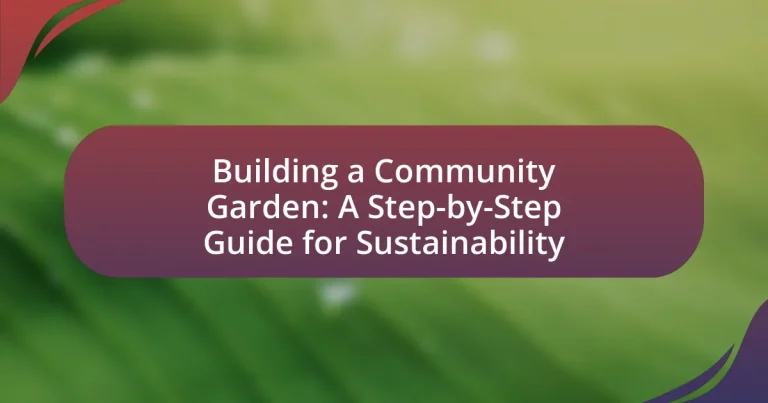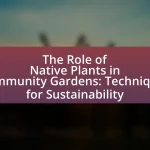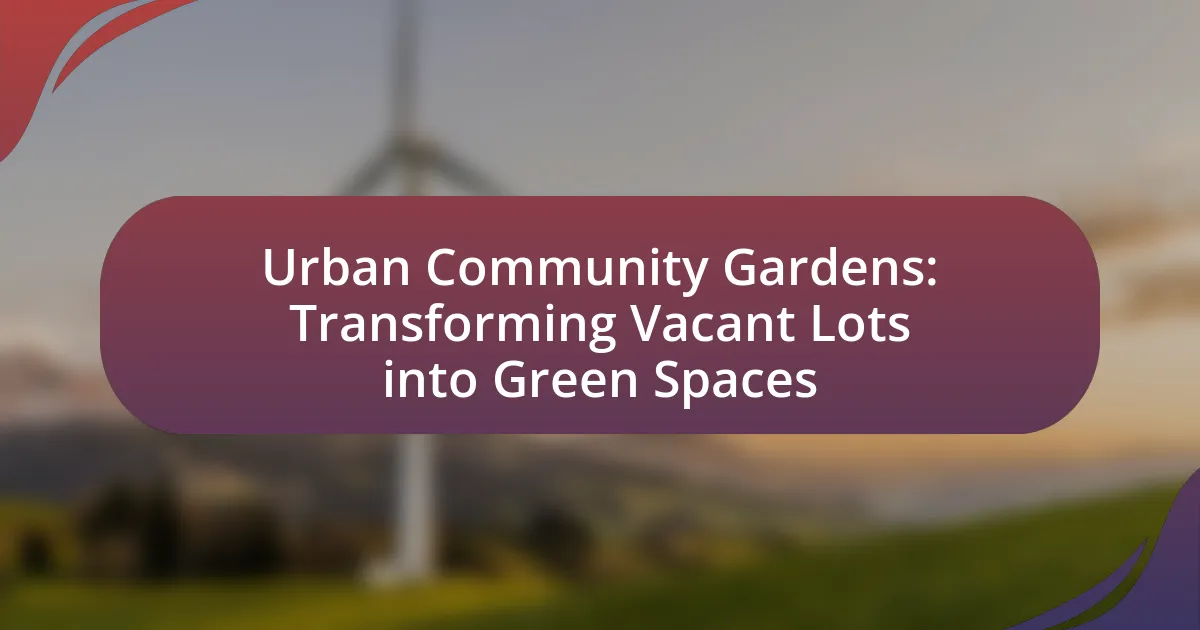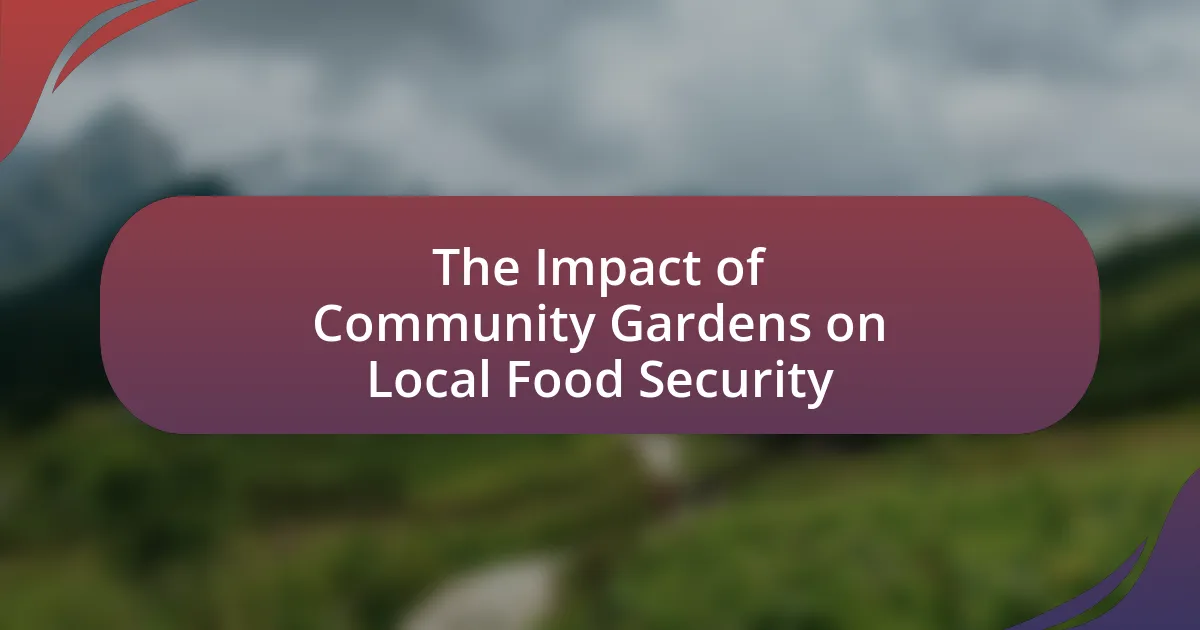A community garden is a shared space where individuals cultivate plants for personal use or community benefit, promoting local food production and environmental sustainability. This article outlines the significance of community gardens, highlighting their contributions to sustainability, social cohesion, and local economies. It details the essential steps for building a community garden, including site selection, community engagement, and resource management, while also addressing challenges such as pest control and resource limitations. Best practices for maintaining a community garden and strategies for ensuring ongoing community involvement are also discussed, emphasizing the importance of sustainable gardening techniques and effective funding models.

What is a Community Garden?
A community garden is a shared space where individuals come together to cultivate plants, typically vegetables, fruits, and flowers, for personal use or community benefit. These gardens promote local food production, enhance community engagement, and foster environmental sustainability. According to the American Community Gardening Association, community gardens can improve neighborhood aesthetics, provide educational opportunities, and strengthen social ties among participants.
How does a community garden contribute to sustainability?
A community garden contributes to sustainability by promoting local food production, reducing carbon footprints, and enhancing biodiversity. By growing food locally, community gardens decrease the need for transportation, which lowers greenhouse gas emissions associated with food distribution. Additionally, these gardens often utilize organic practices that improve soil health and reduce chemical runoff, fostering a healthier ecosystem. Research indicates that urban agriculture, including community gardens, can significantly increase local biodiversity by providing habitats for various species, thus supporting ecological balance.
What are the key features of a sustainable community garden?
Key features of a sustainable community garden include biodiversity, organic practices, community involvement, and resource efficiency. Biodiversity is essential as it promotes a variety of plants and wildlife, enhancing ecosystem resilience. Organic practices, such as composting and natural pest control, reduce chemical use and improve soil health. Community involvement fosters a sense of ownership and encourages educational opportunities, leading to greater engagement and sustainability. Resource efficiency, including rainwater harvesting and energy conservation, minimizes environmental impact and promotes self-sufficiency. These features collectively contribute to the long-term viability and ecological health of the garden.
How does community involvement enhance sustainability in gardens?
Community involvement enhances sustainability in gardens by fostering collaboration, resource sharing, and local stewardship. When community members actively participate in gardening efforts, they contribute diverse skills and knowledge, which leads to more effective management of resources and better environmental practices. For instance, studies show that community gardens can increase local biodiversity and improve soil health through collective efforts in composting and organic gardening techniques. Additionally, engaged communities are more likely to advocate for sustainable practices and policies, ensuring long-term support for garden initiatives. This collaborative approach not only strengthens social ties but also promotes a shared responsibility for environmental stewardship, ultimately leading to more resilient and sustainable gardening practices.
Why are community gardens important for local communities?
Community gardens are important for local communities because they promote social interaction, enhance food security, and improve environmental sustainability. These gardens serve as communal spaces where individuals can connect, fostering a sense of belonging and community cohesion. Research indicates that neighborhoods with community gardens experience increased social ties and reduced crime rates, as residents engage more with one another. Additionally, community gardens provide access to fresh produce, which is crucial in areas classified as food deserts, thereby improving nutritional health. According to a study published in the Journal of Community Health, community gardens can increase fruit and vegetable consumption by 50% among participants. Furthermore, these gardens contribute to biodiversity and urban greening, which can mitigate the urban heat island effect and improve air quality.
What social benefits do community gardens provide?
Community gardens provide significant social benefits, including enhanced community cohesion and improved mental well-being. These gardens serve as communal spaces where individuals from diverse backgrounds can collaborate, fostering relationships and a sense of belonging. Research indicates that participation in community gardening can lead to increased social interaction, which is linked to lower levels of loneliness and improved mental health outcomes. For instance, a study published in the Journal of Community Health found that individuals involved in community gardens reported higher levels of social support and community engagement. Additionally, community gardens often promote educational opportunities, allowing participants to learn about sustainable practices and nutrition, further strengthening community ties.
How do community gardens impact local economies?
Community gardens positively impact local economies by increasing access to fresh produce, fostering local job creation, and enhancing property values. These gardens provide affordable food options, which can reduce grocery costs for residents and stimulate local spending. A study by the American Community Gardening Association found that community gardens can increase property values by up to 9% in surrounding areas. Additionally, they create employment opportunities through garden management, maintenance, and local markets, contributing to economic growth. Furthermore, community gardens often attract visitors, boosting local businesses and promoting community engagement, which further strengthens the local economy.
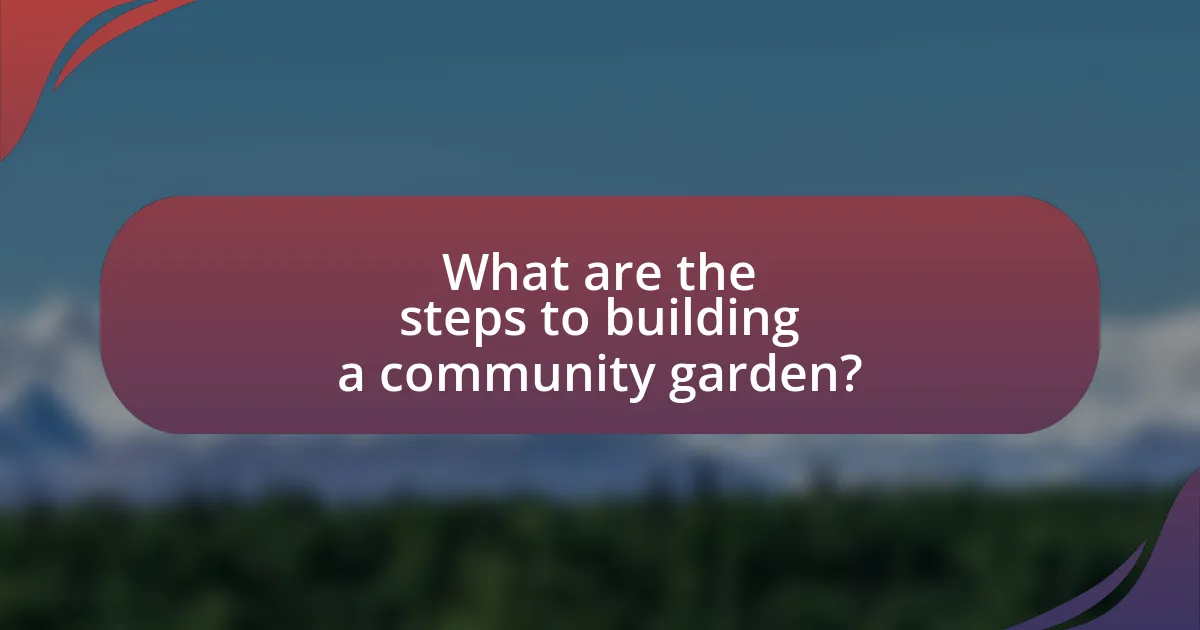
What are the steps to building a community garden?
To build a community garden, follow these steps: first, gather a group of interested community members to form a planning committee. This committee will help identify a suitable location, which should have access to sunlight, water, and good soil. Next, secure permission from landowners or local authorities to use the chosen site. After that, design the garden layout, including plots for individual gardeners, communal spaces, and pathways. Once the design is finalized, prepare the site by clearing debris, tilling the soil, and adding compost or other amendments as needed. Following site preparation, organize a planting day where community members can plant seeds or seedlings together. Finally, establish a maintenance plan that includes regular watering, weeding, and harvesting, ensuring that all members contribute to the upkeep of the garden. These steps are supported by community gardening initiatives that emphasize collaboration and sustainability, such as those documented by the American Community Gardening Association.
How do you select a suitable location for a community garden?
To select a suitable location for a community garden, assess factors such as sunlight exposure, soil quality, water access, and community accessibility. A location should receive at least six hours of direct sunlight daily, as this is essential for plant growth. Soil should be tested for contaminants and nutrient levels; ideally, it should be loamy and well-draining. Access to water is crucial, as gardens require regular irrigation, and proximity to community members enhances participation and maintenance. According to the American Community Gardening Association, successful gardens often thrive in areas that are easily reachable by foot or public transport, fostering community engagement and sustainability.
What factors should be considered when choosing a site?
When choosing a site for a community garden, factors such as sunlight exposure, soil quality, water access, proximity to the community, and zoning regulations must be considered. Sunlight exposure is crucial as most vegetables require at least six hours of direct sunlight daily. Soil quality affects plant growth; testing for contaminants and nutrient levels is essential. Access to water is necessary for irrigation, and the site should be conveniently located for community members to encourage participation. Lastly, zoning regulations can dictate what can be grown and how the land can be used, making it vital to ensure compliance with local laws.
How can you assess soil quality and sunlight exposure?
To assess soil quality, conduct a soil test that measures pH, nutrient levels, and organic matter content, which indicates fertility and health. For sunlight exposure, observe the area throughout the day to determine the amount of direct sunlight received, categorizing it as full sun (6+ hours), partial shade (3-6 hours), or full shade (less than 3 hours). Soil tests can be performed using kits available from agricultural extension services or garden centers, while sunlight exposure can be evaluated using a simple observation method or sunlight calculators available online.
What planning is necessary before starting a community garden?
Before starting a community garden, it is essential to conduct thorough planning that includes site selection, community engagement, and resource assessment. Site selection involves identifying a suitable location with adequate sunlight, water access, and soil quality, which are critical for plant growth. Community engagement is necessary to gather input from potential participants, ensuring that the garden meets the needs and interests of the community. Resource assessment includes evaluating available funding, tools, and materials, as well as determining ongoing maintenance responsibilities. These planning steps are supported by studies indicating that successful community gardens often result from careful consideration of location, community involvement, and resource management.
How do you gather community input and support?
To gather community input and support for building a community garden, conduct surveys and host community meetings to solicit feedback and ideas. Engaging local residents through these methods allows for the collection of diverse perspectives and fosters a sense of ownership among community members. Research indicates that community involvement in decision-making processes increases project success rates; for instance, a study by the American Community Gardening Association found that gardens with strong community input are more sustainable and better maintained.
What are the essential permits and regulations to consider?
The essential permits and regulations to consider when building a community garden include zoning permits, land use permits, and health department regulations. Zoning permits ensure that the garden complies with local land use laws, while land use permits may be required for specific activities such as composting or installing structures. Health department regulations often govern the use of water sources and food safety practices. Compliance with these permits and regulations is crucial to avoid legal issues and ensure the garden operates within the law.
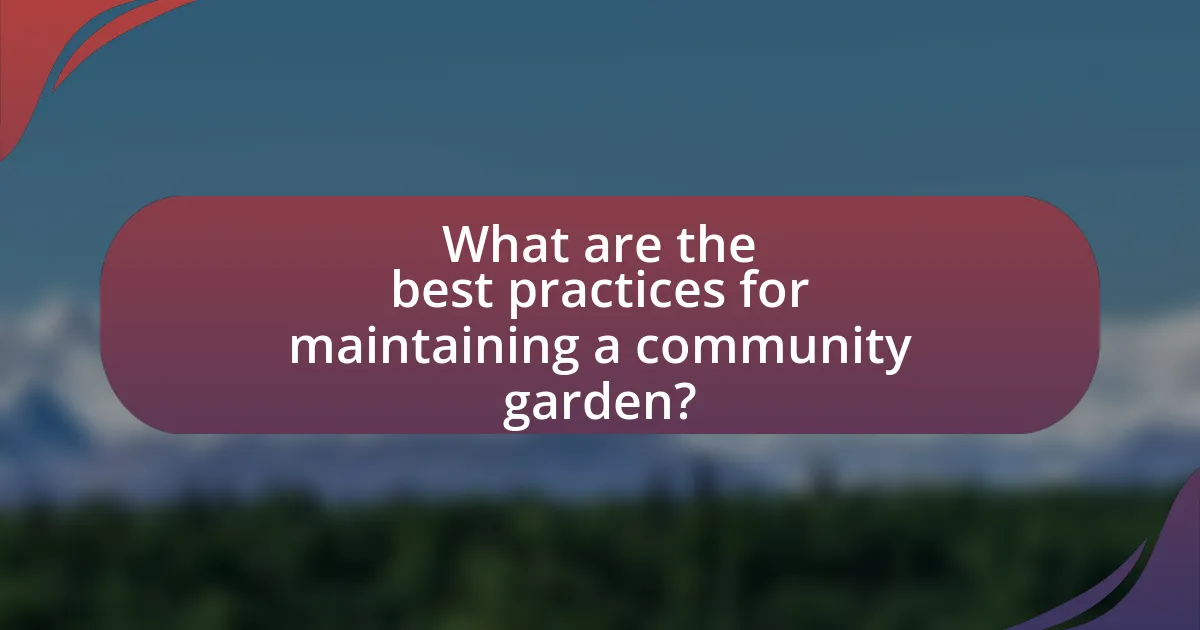
What are the best practices for maintaining a community garden?
The best practices for maintaining a community garden include regular watering, weeding, and pest management. Consistent watering ensures plants receive adequate moisture, which is crucial for growth; gardens typically require about an inch of water per week. Weeding prevents competition for nutrients and space, and should be done weekly to keep the garden healthy. Implementing integrated pest management techniques, such as introducing beneficial insects and using organic pesticides, helps control pests without harming the ecosystem. Additionally, rotating crops annually can improve soil health and reduce disease risk. These practices are supported by agricultural studies indicating that proper maintenance significantly enhances yield and sustainability in community gardens.
How can you ensure ongoing community engagement in the garden?
To ensure ongoing community engagement in the garden, implement regular events and activities that invite participation from community members. Organizing workshops, seasonal planting days, and harvest festivals fosters a sense of ownership and belonging among participants. Research shows that community gardens with consistent programming see higher levels of engagement; for example, a study by the American Community Gardening Association found that gardens with monthly events had 40% more active participants compared to those without. Additionally, establishing a communication channel, such as a newsletter or social media group, keeps community members informed and connected, further enhancing their involvement.
What activities can promote participation and education?
Activities that can promote participation and education in building a community garden include hands-on workshops, planting days, and educational seminars. Hands-on workshops allow community members to learn gardening techniques and sustainable practices directly, fostering engagement and skill development. Planting days encourage collective action, where participants work together to plant seeds and maintain the garden, enhancing community bonds and shared responsibility. Educational seminars can provide valuable information on topics such as composting, pest management, and the benefits of native plants, thereby increasing knowledge and awareness among participants. These activities not only facilitate learning but also create a sense of ownership and commitment to the community garden project.
How do you handle conflicts and maintain a positive environment?
To handle conflicts and maintain a positive environment in a community garden, open communication and active listening are essential. Engaging all members in discussions about issues fosters a sense of belonging and encourages collaborative problem-solving. Research indicates that communities with strong communication practices experience 30% fewer conflicts, as members feel heard and valued. Additionally, establishing clear guidelines and roles within the garden helps prevent misunderstandings and promotes accountability. By prioritizing inclusivity and respect, a positive atmosphere is cultivated, leading to a more sustainable and enjoyable gardening experience for everyone involved.
What sustainable gardening techniques should be implemented?
Sustainable gardening techniques that should be implemented include composting, crop rotation, and integrated pest management. Composting enriches soil health by recycling organic waste, which can improve plant growth and reduce the need for chemical fertilizers. Crop rotation helps prevent soil depletion and reduces pest and disease buildup by alternating the types of crops grown in a specific area. Integrated pest management combines biological, cultural, and mechanical practices to control pests in an environmentally friendly way, minimizing the use of harmful pesticides. These techniques are supported by research indicating that sustainable practices enhance biodiversity, improve soil quality, and promote ecosystem health.
How can organic practices enhance garden health?
Organic practices enhance garden health by promoting biodiversity, improving soil quality, and reducing chemical inputs. These practices, such as crop rotation, composting, and the use of natural pest control methods, foster a balanced ecosystem that supports beneficial organisms. Research indicates that organic farming can increase soil organic matter by 20-30%, which enhances nutrient retention and water infiltration, leading to healthier plants. Additionally, organic methods reduce reliance on synthetic fertilizers and pesticides, minimizing harmful runoff and protecting local waterways. This holistic approach not only boosts plant resilience but also contributes to a sustainable gardening environment.
What role does biodiversity play in a community garden?
Biodiversity plays a crucial role in a community garden by enhancing ecosystem resilience and productivity. A diverse range of plants, insects, and microorganisms contributes to improved soil health, pest control, and pollination, which are essential for the growth of healthy crops. Studies show that gardens with higher biodiversity can yield up to 20% more produce compared to monoculture gardens, as diverse plant species can better utilize resources and support a wider array of beneficial organisms. This interconnectedness fosters a balanced ecosystem, reducing the need for chemical inputs and promoting sustainable gardening practices.
What are common challenges faced in community gardens?
Common challenges faced in community gardens include issues related to resource management, community engagement, and environmental factors. Resource management challenges often arise from limited funding, which can restrict access to necessary tools, seeds, and maintenance supplies. Community engagement difficulties may stem from varying levels of commitment among participants, leading to inconsistent participation and maintenance of the garden. Environmental factors, such as soil quality, pests, and weather conditions, can also pose significant obstacles, impacting plant growth and overall garden productivity. These challenges are frequently documented in studies on urban agriculture, highlighting the need for effective planning and community involvement to overcome them.
How can you address issues related to pests and diseases?
To address issues related to pests and diseases in a community garden, implement integrated pest management (IPM) strategies. IPM combines biological control, cultural practices, and chemical methods to minimize pest populations while reducing harm to beneficial organisms. For example, introducing natural predators like ladybugs can effectively control aphid populations, while crop rotation can disrupt pest life cycles and reduce disease incidence. Research shows that gardens utilizing IPM techniques experience up to 50% fewer pest-related issues compared to those relying solely on chemical pesticides.
What strategies can help manage limited resources?
To manage limited resources effectively in building a community garden, prioritizing resource allocation is essential. This involves assessing the most critical needs of the garden, such as soil, seeds, and water, and directing available resources towards those priorities. For instance, utilizing native plants can reduce water usage and maintenance costs, as they are adapted to the local climate. Additionally, implementing a shared tool library allows community members to access necessary gardening tools without the need for each individual to purchase them, thereby maximizing resource efficiency. Research indicates that community gardens can increase local biodiversity and food security, demonstrating the effectiveness of these strategies in sustainable practices.
What tips can help ensure the success of a community garden?
To ensure the success of a community garden, it is essential to establish clear goals and involve the community in the planning process. Engaging local residents fosters ownership and commitment, which are critical for sustainability. Research indicates that community involvement increases participation rates and enhances the garden’s longevity. Additionally, selecting a suitable location with adequate sunlight, water access, and soil quality is vital, as these factors directly impact plant growth and productivity. Regular maintenance schedules and shared responsibilities among members help maintain the garden’s health and aesthetics. Furthermore, providing educational workshops on gardening techniques and sustainable practices can empower participants and improve overall garden management.
How can you create a sustainable funding model for the garden?
To create a sustainable funding model for the garden, establish diverse revenue streams such as membership fees, grants, and community fundraising events. Membership fees provide a steady income, while grants from local governments or non-profits can support specific projects; for instance, the USDA offers grants for community gardens that can cover operational costs. Additionally, organizing fundraising events like plant sales or workshops can engage the community and generate funds. Research indicates that community gardens with multiple funding sources are more resilient, as demonstrated by a study from the American Community Gardening Association, which found that gardens with diversified funding were 30% more likely to thrive over five years compared to those relying on a single source.
What are the best ways to celebrate and share the garden’s achievements?
The best ways to celebrate and share the garden’s achievements include hosting a community event, creating a visual display of progress, and utilizing social media platforms. Hosting a community event, such as a harvest festival, allows participants to gather, share experiences, and enjoy the fruits of their labor, fostering a sense of community. Creating a visual display, like a photo collage or timeline, showcases the garden’s growth and milestones, making achievements tangible and inspiring. Utilizing social media platforms enables the garden’s achievements to reach a wider audience, encouraging community engagement and attracting new members. These methods effectively highlight the garden’s successes and strengthen community bonds.
